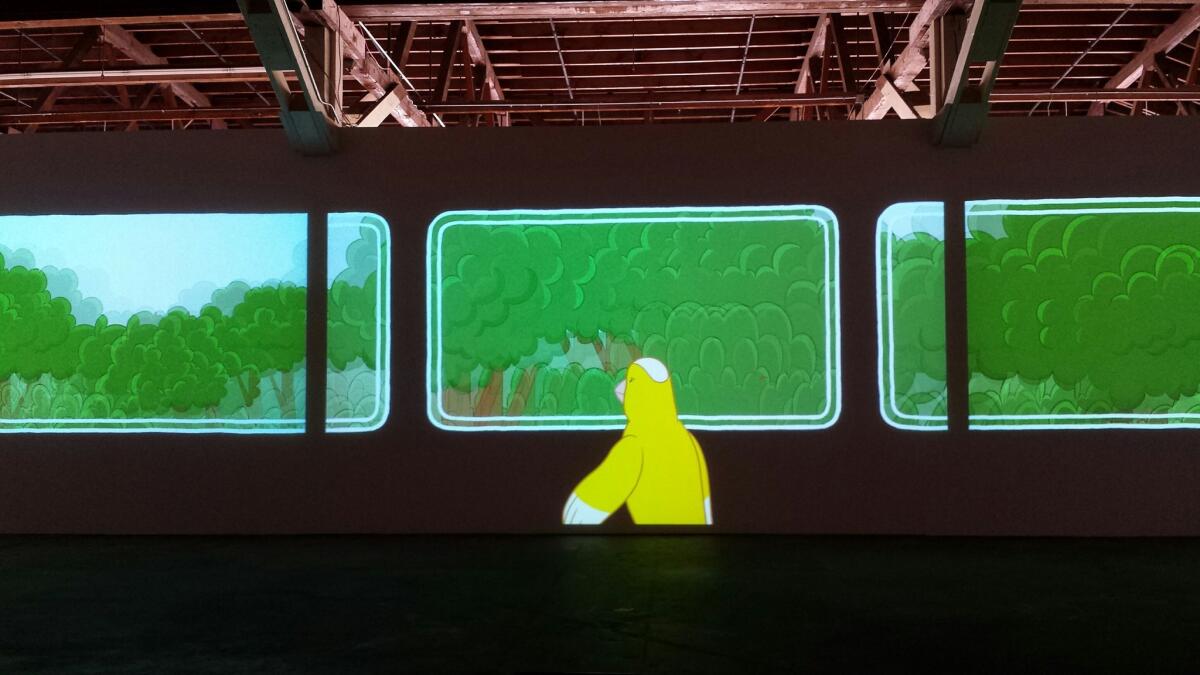Pulling back for the big picture of media overload

Kerry Tribe, “The Aphasia Poetry Club,” 2015, video installation still
The intersection of memory, language and perception is often congested – and sometimes even clogged. The presence of symbolic signals doesn’t always help the traffic flow.
Kerry Tribe has been productively working at the busy juncture for at least 15 years. “The Loste Note,” her new mixed-media sculpture and video installation at 356 Mission is among the most resonant excursions yet.
The title’s spelling aberration, in which “lost” gets tweaked to rhyme with “note,” is a clue. Language is malleable and elusive, as easily lost as an evaporating musical chord. As it disappears, however, it might open up a space for something new – for poetry.
The show’s centerpiece is “The Aphasia Poetry Club,” a three-channel, half-hour video “mural” narrated by two men and one woman. They are afflicted with a communication disorder that results from damage to the parts of the brain where language takes shape. (Aphasia is often the result of a stroke.) Tribe’s video projection mixes photographic images with animation.
As one aphasiac speaker describes the effect, information arrives more rapidly and in greater volume than her brain can process, leading to disorientation and unexpected perspectives. The video illustrates the effect in surprising ways.
The triptych might simply line up an apartment building’s second-floor walkway shown at a precarious tilt, then the apartment’s front door in a view that is blocked by a post and, finally, a vertiginous view down to a ground-level sidewalk that splits in two, interrupted by a bush. Your mind starts connecting the speaker’s struggling voice, which recalls an episode of stumbling into a hedge, to the blockages and confusion implied by the pictures.
Oddly, the faceted composition also recalls a Cubist painting. But it moves by too quickly to take it all in.
The exposition of aphasia marches on, with Tribe slowly building imagery to accompany the speakers’ narratives. The pictures include packed bookshelves, the solar system, geological specimens, Cambodia’s killing fields and a scattering of letters, which looks like alphabet soup.
Sometimes it switches over to animation. One speaker talks about his experience as a Navy SEAL, another relates his mother’s intimate interactions with birds. A cartoon seal in a naval uniform and a jaunty yellow bird arrive.
Uncomplicated, brightly colored and almost childlike in style, the animations lend ingenuous sweetness to a difficult situation. The cartoons build to a happy crescendo that comes as a relief – not least because some scenes were shot inside the very gallery in which we are watching the video. Dysfunction is all around us.
On the other side of the big video wall, mixed-media sculptures are composed from the microphone booms and lighting stands common to a television studio. None functions as expected. One seems to hold up a wall, another is twisted into a graceful arabesque, like a dancer.
Each sleek, chrome tube has been bent out of shape and extruded. They’re abstract drawings in space.
Something soon dawns: The overload with which these aphasiacs struggle might also describe an entire society.
Media-filtered information today arrives more rapidly and in greater volume than a brain can process. Overwhelmed by an excessive barrage of nonstop verbal and visual data, we are all aphasiac now.
356 Mission, 356 S. Mission Road, (323) 609-3162, through May 31. Closed Monday and Tuesday. www.356mission.com
More to Read
The biggest entertainment stories
Get our big stories about Hollywood, film, television, music, arts, culture and more right in your inbox as soon as they publish.
You may occasionally receive promotional content from the Los Angeles Times.











